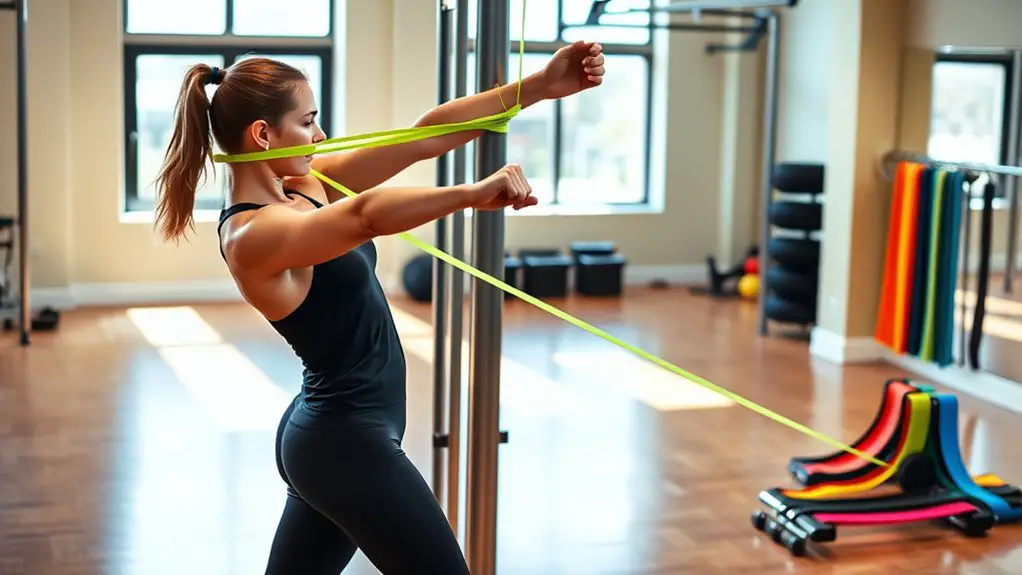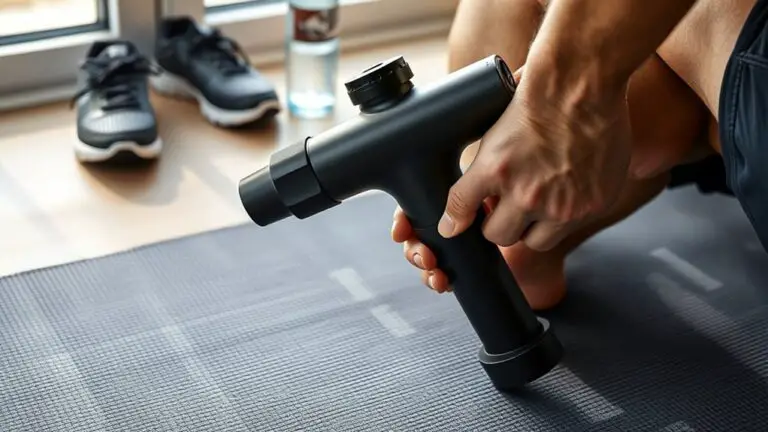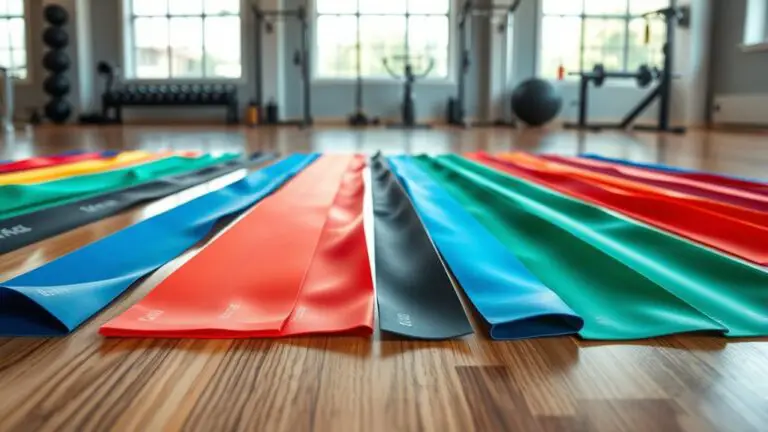How to Use Resistance Bands for Mobility Work

To use resistance bands for mobility work, start by choosing the right band based on your objectives. Incorporate essential warm-up exercises like band pull-aparts and lateral band walks to enhance flexibility and stability. Focus on targeted exercises for areas like the hips, shoulders, and ankles to improve range of motion. Finally, consistently integrate bands into your routine and progressively increase resistance for best results. Keep exploring to discover more advanced techniques and exercises.
Benefits of Using Resistance Bands for Mobility

Using resistance bands for mobility work offers several key benefits that can enhance your overall flexibility and joint health. One of the primary advantages is improved flexibility, as these bands provide a controlled way to stretch various muscle groups. This allows you to target specific areas, promoting greater range of motion in your joints. Additionally, resistance bands facilitate dynamic movements that help strengthen the muscles surrounding your joints, leading to enhanced stability.
Incorporating resistance bands into your mobility routine can also reduce the risk of injury by ensuring that your muscles and connective tissues are adequately prepared for more strenuous activities. The adjustable resistance levels allow for gradual progression, accommodating your current fitness level while encouraging development over time. Overall, utilizing resistance bands effectively supports both flexibility and stability, making them an essential tool in any mobility-focused exercise regimen.
Choosing the Right Resistance Band
Selecting the right resistance band is essential for maximizing the benefits of your mobility work. Understanding band types and resistance levels will help you make an informed choice.
Choosing the right resistance band is crucial for enhancing your mobility work and achieving your fitness goals effectively.
- Band Types: Resistance bands come in various forms, including loop bands, tube bands, and fabric bands, each serving different purposes.
- Resistance Levels: Bands are available in light, medium, and heavy resistance levels. Choosing the appropriate resistance is vital, as it should challenge you without compromising your form.
- Personal Goals: Consider your specific mobility objectives, whether it’s improving flexibility, strength, or stability.
Essential Warm-Up Exercises With Resistance Bands

Incorporating resistance bands into your warm-up routine can enhance mobility and prepare your muscles for activity. Key exercises such as band pull-aparts, lateral band walks, and the overhead band stretch effectively target various muscle groups and improve flexibility. By integrating these movements, you can optimize your performance and reduce the risk of injury.
Band Pull-Aparts
Band pull-aparts are a fundamental exercise for enhancing shoulder mobility and stability, making them an excellent addition to your warm-up routine. To perform this exercise effectively, focus on proper band positioning and avoid common mistakes.
- Stand tall with your feet shoulder-width apart, holding the band with both hands at shoulder height.
- Pull the band apart by extending your arms out to the sides while keeping your elbows slightly bent.
- Verify your shoulder blades retract together as you perform the movement.
Common mistakes include using an overly tight band, which can compromise form, and allowing your arms to drop below shoulder level. By following these guidelines, you’ll improve your shoulder function and prepare your body for more intense activities.
Lateral Band Walks
Lateral band walks are an effective way to activate and strengthen the muscles around your hips, which is essential for maintaining proper mobility and stability during various movements. To perform this exercise, place a resistance band just above your knees and stand with your feet hip-width apart. Engage your core and maintain a slight bend in your knees. As you step to the side, make sure there’s constant band tension, focusing on controlled lateral movement. Take small, deliberate steps, moving laterally for about 10-15 steps in one direction before returning. This exercise not only enhances hip stability but also improves coordination and balance, making it a valuable addition to your warm-up routine. Incorporate it regularly for best results.
Overhead Band Stretch
To further enhance your warm-up routine, the overhead band stretch targets the upper body, particularly the shoulders and thoracic spine. This exercise promotes mobility and prepares your muscles for more intensive activity.
To perform the overhead stretch effectively, consider the following band positioning:
- Grip the band: Hold the resistance band with both hands, palms facing forward, and stretch it overhead.
- Maintain tension: Keep a slight bend in your elbows and guarantee the band remains taut throughout the movement.
- Engage your core: Stabilize your torso to prevent excessive arching of the lower back while you hold the stretch for 20-30 seconds.
Incorporating this stretch into your routine will enhance flexibility and reduce the risk of injury during subsequent workouts.
Targeted Mobility Exercises for Different Areas

To enhance your mobility, it’s essential to focus on specific areas such as the hips, shoulders, and ankles. Each region requires targeted exercises that utilize resistance bands for effective stretching and strengthening. By incorporating these techniques, you can improve your overall range of motion and functional performance.
Hip Mobility Exercises
While many people focus on strength training, incorporating hip mobility exercises with resistance bands can greatly enhance your overall flexibility and range of motion. Utilizing resistance bands allows for dynamic stretching and stabilization, particularly for the hip area. Here are three effective exercises to reflect on:
- Banded Squats: Attach a band around your thighs and squat, ensuring your knees don’t cave in. This strengthens your hips while promoting alignment.
- Hip Flexor Stretches: Anchor a band to a sturdy object and loop it around your foot. Step back to feel a stretch in your hip flexor, enhancing flexibility.
- Lateral Band Walks: Position the band around your ankles and take side steps, engaging your hip abductors for improved stability.
Incorporating these exercises can greatly improve your hip mobility.
Shoulder Mobility Techniques
Shoulder mobility is essential for maintaining proper movement patterns and preventing injuries, especially if you engage in upper body workouts or activities requiring overhead motions. To enhance your shoulder mobility, incorporate shoulder circles with resistance bands. Start by anchoring the band at shoulder height, grasping it with one hand. Perform small circles, gradually increasing the diameter to improve range of motion.
Additionally, resistance band stretches can be effective. Attach the band at a low point, hold it with one hand, and step back to create tension. Gently pull the band across your body, focusing on stretching the shoulder joint. These targeted exercises promote flexibility and strength, ultimately enhancing your overall shoulder mobility and performance during physical activities.
Ankle Mobility Drills
Ankle mobility is essential for overall movement efficiency and injury prevention, especially for activities involving running, jumping, or squatting. Incorporating targeted drills can enhance your ankle dorsiflexion and overall mobility. Here are three effective exercises to include in your routine:
- Ankle Circles: Stand on one leg and rotate the other foot in circular motions to improve joint flexibility.
- Dorsiflexion Stretch: Use a resistance band to pull your foot towards you while keeping your heel on the ground, promoting ankle dorsiflexion.
- Heel Raises: Stand on the edge of a step, lowering your heels below the step level, then rising onto your toes to strengthen the calves and enhance mobility.
Incorporate these drills regularly for ideal ankle function and performance.
Incorporating Resistance Bands Into Your Routine

Incorporating resistance bands into your routine can markedly enhance your mobility work, as they provide both support and resistance, allowing for a more dynamic range of motion. When you start combining resistance bands with traditional mobility exercises, you enable more targeted muscle activation and joint stabilization. You can utilize various band variations, including loop bands, tube bands, and mini bands, to tailor your approach according to your specific mobility goals.
For instance, using loop bands for hip mobility can effectively engage the glutes while simultaneously stretching the hip flexors. Adding bands to your routine helps you maintain proper alignment and control during movements, reducing the risk of injury. Additionally, you can progressively increase resistance by opting for thicker bands or altering the position of the bands to challenge yourself more. By integrating these strategies, you’ll likely notice significant improvements in your overall mobility and functional movement patterns.
Tips for Progressing Your Mobility Work With Resistance Bands
To enhance your mobility work with resistance bands, it’s important to implement strategies that facilitate progression. Addressing mobility challenges requires a structured approach, utilizing progressive resistance to guarantee continuous improvement. Here are a few tips to take into account:
- Gradually Increase Resistance: Start with lighter bands and progressively move to heavier ones to challenge your muscles and enhance flexibility.
- Vary Your Exercises: Incorporate a range of movements targeting different muscle groups, promoting overall joint mobility and stability.
- Focus on Form: Prioritize proper technique to minimize injury risk and maximize the effectiveness of each exercise.
Frequently Asked Questions
Can Resistance Bands Help With Injury Rehabilitation?
Yes, resistance bands can greatly aid in injury rehabilitation. They allow for controlled resistance during rehabilitation exercises, which helps strengthen the affected area without overloading it. The resistance band benefits include improved range of motion, increased muscle activation, and enhanced stability. By incorporating bands into your routine, you can tailor your exercises to target specific muscles, making your rehabilitation more effective and safer as you work towards recovery.
How Often Should I Use Resistance Bands for Mobility?
To maximize mobility benefits, you should incorporate resistance bands into your daily routine about three to five times a week. This frequency allows for adequate recovery while promoting flexibility and strength. Start with short sessions focusing on specific areas, gradually increasing duration and intensity as your comfort grows. Consistency is key; regular use will enhance your overall mobility and support injury prevention, making it a valuable addition to your fitness regimen.
Are There Any Safety Concerns With Resistance Bands?
Using resistance bands can be like walking a tightrope; one misstep can lead to injury. To stay safe, always consider band quality; cheap bands can snap, causing harm. Ensuring proper technique is essential, too; poor form can strain muscles or joints. Always inspect your bands for wear and tear before use, and avoid overstretching them. By following these guidelines, you’ll keep your workouts effective and injury-free, turning your training into a safe dance of strength.
Can I Use Resistance Bands for Strength Training Too?
Yes, you can definitely use resistance bands for strength training. Their versatility allows you to target various muscle groups effectively. Resistance bands provide strength training benefits like improved muscle endurance and flexibility while reducing the risk of injury. You can adjust the resistance level to suit your fitness level, making them suitable for beginners and advanced users alike. Incorporating them into your routine can enhance your overall strength and performance greatly.
Where Can I Buy High-Quality Resistance Bands?
Where can you find high-quality resistance bands that meet your training needs? The best brands, such as TheraBand, Bodylastics, and ProForm, offer durable options. You can purchase these bands from reputable online retailers like Amazon, Walmart, or specialized fitness sites. It’s crucial to read customer reviews and check for warranty information to guarantee you’re getting a reliable product. Investing in quality bands can greatly enhance your workout experience and longevity.





